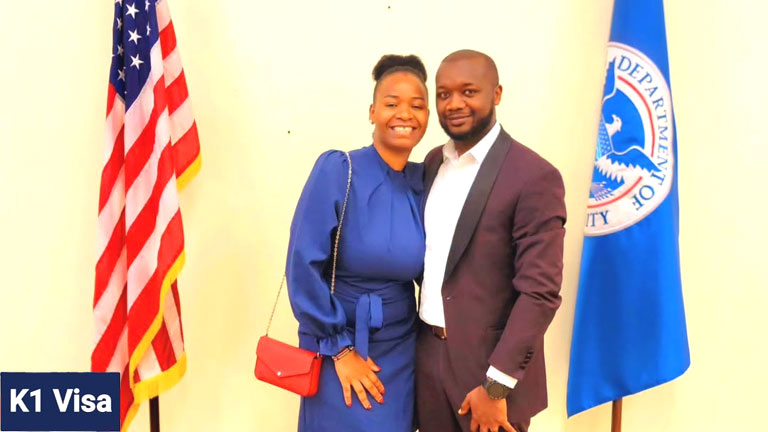
Romantic relationships that cross international borders can be exciting, but they can also involve complex concerns related to immigration. When a U.S. citizen plans to marry someone from another country, and the couple plans to live together in the United States, they may need to take specific steps to ensure that their partner will receive authorization to come to the country. The K-1 fiancé(e) visa is designed for this purpose. It can provide a path for engaged couples to unite and marry. Understanding when and how to apply for a K-1 visa and the requirements and follow-up steps involved in this process can help couples navigate issues related to immigration.
The Purpose of the K-1 Visa
The K-1 visa allows a U.S. citizen to bring a foreign fiancé(e) to the United States legally to get married. The K-1 visa is a temporary, non-immigrant visa that enables the foreign national to come to the United States for 90 days. The couple will be required to get married during that 90-day period.
A K-1 visa will not be available in situations where couples are already married or when a couple plans to marry in another country. In those cases, other visa categories may be more appropriate, including immediate relative visas for spouses of U.S. citizens.
Eligibility Requirements for the K-1 Visa
Only a U.S. citizen can sponsor a fiancé(e) for a K-1 visa. This option is not available for lawful permanent residents (Green Card holders). A couple’s eligibility for a K-1 visa will be based on factors such as:
- Valid Relationship: The couple must demonstrate that they have a genuine, ongoing relationship and intend to get married. This may be supported by evidence such as correspondence, photographs, travel records, or other documentation.
- Meeting in Person: The couple must have met in person at least once within a two-year window before they file a K-1 visa application. In some cases, couples may qualify for an exemption to this requirement based on cultural traditions or extreme hardship.
- Legal Ability to Marry: Each party must be old enough to become legally married. If there were any previous marriages, they must have been lawfully terminated through divorce or annulment, or a person may show that their former spouse has died.
- Marriage Within 90 days: The citizen and the foreign fiancé(e) must plan to get married within 90 days of the fiancé(e)’s arrival.
- Financial Support: The citizen must provide information about their income and financial resources to demonstrate that they have the ability to support the fiancé(e) and prevent reliance on public benefits.
- Admissibility: The foreign fiancé(e) must be legally admissible to the United States. They must have no disqualifying criminal, medical, or immigration violations.
Steps Followed When Applying for a K-1 Visa
1. Filing the Petition
The application process will begin when the citizen files Form I-129F, which is a petition for a visa for their fiancé(e). This form establishes the relationship and demonstrates eligibility.
2. Visa Application and Consular Interview
An approved petition will be forwarded to the U.S. consulate or embassy in the fiancé(e)’s home country. The foreign fiancé(e) will then complete their visa application and attend a consular interview. During the interview, a consular officer will review the documentation provided in the application, verify that the relationship is genuine, and address any other concerns that may affect eligibility for a K-1 visa.
3. Arrival and Marriage
After receiving their approval for a K-1 visa, the fiancé(e) may travel to the United States. Upon arrival, the 90-day countdown begins. The couple must marry within that period; otherwise, the fiancé(e) will be required to leave the country. If they do not leave voluntarily, they could face deportation.
Conditional Permanent Residence After Marriage
After a K-1 visa holder marries a U.S. citizen and applies for an adjustment of status, they will be issued a conditional, temporary Green Card. This will grant them lawful permanent resident status for two years. While a conditional Green Card serves as proof of lawful residence, it is subject to review to confirm that the marriage is genuine and ongoing.
To remove the conditions on a temporary Green Card and obtain full permanent resident status, the couple can file Form I-751, which is a petition to remove the conditions on the foreign spouse’s permanent residence. This form must be filed within the 90-day period before the Green Card expires. The couple may need to provide evidence showing that they have a genuine married relationship. Evidence such as joint financial records, lease agreements, and photographs can help establish the legitimacy of the marriage.
If the couple has divorced, or if the citizen spouse has passed away, the foreign spouse may still apply to remove conditions individually. They will be required to demonstrate that the marriage was genuine. If immigration officials believe that the marriage was fraudulent, a permanent Green Card may be denied, and the person may be required to leave the United States.
Visas for Children of Foreign Fiancé(e)s
Children of the foreign fiancé(e) may also be eligible to accompany their parent to the United States. K-2 visas may be available to unmarried children who are under the age of 21. Each child must be listed in the original I-129F petition, and they must meet the same admissibility requirements as the fiancé(e). After the marriage takes place, children may also apply for adjustment of status and obtain Green Cards, following similar procedures as their parents.
Addressing Issues Related to K-1 Visas
The K-1 visa can help couples separated by national borders to unite and begin their married lives together. The process involves multiple steps, and careful attention may need to be paid to eligibility requirements, documentation, and deadlines. An experienced immigration attorney can assist with the application process, helping couples compile the necessary documentation, fill out and submit forms, and meet other requirements.


